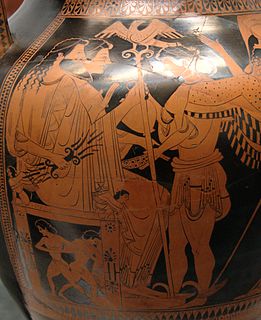
Black-figure pottery painting, also known as the black-figure style or black-figure ceramic, is one of the styles of painting on antique Greek vases. It was especially common between the 7th and 5th centuries BC, although there are specimens dating as late as the 2nd century BC. Stylistically it can be distinguished from the preceding orientalizing period and the subsequent red-figure pottery style.

Red-figure vase painting is one of the most important styles of figural Greek vase painting.

The Kleophrades Painter is the name given to the anonymous red-figure Athenian vase painter, who was active from approximately 510–470 BC and whose work, considered amongst the finest of the red-figure style, is identified by its stylistic traits.

The Affecter was an Attic black-figure vase painter, active in Athens around 550 to 530 BCE.

Psiax was an Attic vase painter of the transitional period between the black-figure and red-figure styles. His works date to circa 525 to 505 BC and comprise about 60 surviving vases, two of which bear his signature. Initially he was allocated the name "Menon Painter" by John Beazley. Only later was it realised that the artist was identical with the painters signing as "Psiax".

The Kerch style, also referred to as Kerch vases, is an archaeological term describing vases from the final phase of Attic red-figure pottery production. Their exact chronology remains problematic, but they are generally assumed to have been produced roughly between 375 and 330/20 BC. The style is characterized by slender mannered figures and a polychromatism given to it by the use of white paint and gilding.

The Providence Painter is the conventional name given to a painter of the Attic red-figure style. He was active around 470 BC.

The Phiale Painter, also known as Boston Phiale Painter, was a painter of the Attic red-figure style. He was active around 460 to 430 BC. The Phiale Painter is assumed to have been a pupil of the Achilles Painter. In contrast to his master, he liked to depict narrative scenes. He painted several large calyx kraters, often with two registers of figures; unlike his master, he seems to have preferred larger vessels in general. This is shown by his white-ground works, which are not well known, but more expressive than those of the Achilles Painter. Apart from a number of lekythoi, he painted two chalice kraters in white-ground technique, a rarity at the time. His themes may be partially influenced by contemporary theatre. His preferred name for kalos inscriptions is that of Euaion, son of Aeschylus. His conventional name is based on the fact that a painted phiale, a vase shape rarely equipped with figural depictions, is known from him.
The Marsyas Painter was an ancient Greek vase painter of the red-figure style active in Attica between 370 and 340/330 BC. The Marsyas Painter is sometimes considered the best of the Attic red-figure painters of the late 4th-century Kerch Style.

The Baltimore Painter was an Apulian vase painter whose works date to the final quarter of the 4th century BC. He is considered the most important Late Apulian vase painter, and the last Apulian painter of importance. His conventional name is derived from a vase kept at the Walters Art Museum in Baltimore.

The Painter of Acropolis 606 was a black-figure vase painter, active around 570–560 BC.
The Ptoon Painter was an ancient Greek vase painter of black-figure style active in Athens in the middle third of the 6th century BC. His real name is unknown. The Ptoon Painter predominantly painted ovoid neck amphorae, spherical '’hydriai’’, and Siana cups. His most distinguishing features are figural palmettes and striking black-and-red patterns on the wings of birds. Along with the Camtar Painter, he was one of the last painters to paint animal friezes. His work is considered of mediocre quality. He often used dotted rosettes for the backgrounds, a feature generally out of use at the time of his activity. The late date of his works is attested by certain details of his plant motifs and figures, which resemble the work of Lydos. His most famous work is the Hearst Hydria, on display in New York City.

The Leagros Group was a group of Attic black-figure vase painters active during the last two decades of the 6th century BC. The name given to the group by modern scholars is a conventional one, derived from a series of name vases.

The Swing Painter was an Attic black-figure vase painter, active in the third quarter of the sixth century BC. His real name is unknown.

The Euphiletos Painter was an Attic black-figure vase painter active in the second half of the sixth century BC.

Skythes was an Attic black-figure and red-figure vase painter active between about 520 and 505 BC.

The Lysippides Painter was an Attic vase painter in the black-figure style. He was active around 530 to 510 BC. His real name is not known.

The Nikoxenos Painter was an Attic vase painter who worked in both the black-figure and red-figure styles. He was active in the end of the sixth and the beginning of the fifth centuries BC. His real name is not known.

Klazomenian Sarcophagi are a type of ancient Greek sarcophagus named after the Ionian Greek city of Klazomenai, where most examples were found. They are made of coarse clay in shades of brown to pink. Added to the basin-like main sarcophagus is a rectangular broad frame, often covered with a white slip and then painted.

A Caeretan hydria is a type of ancient Greek painted vase, belonging to the black-figure style.




















